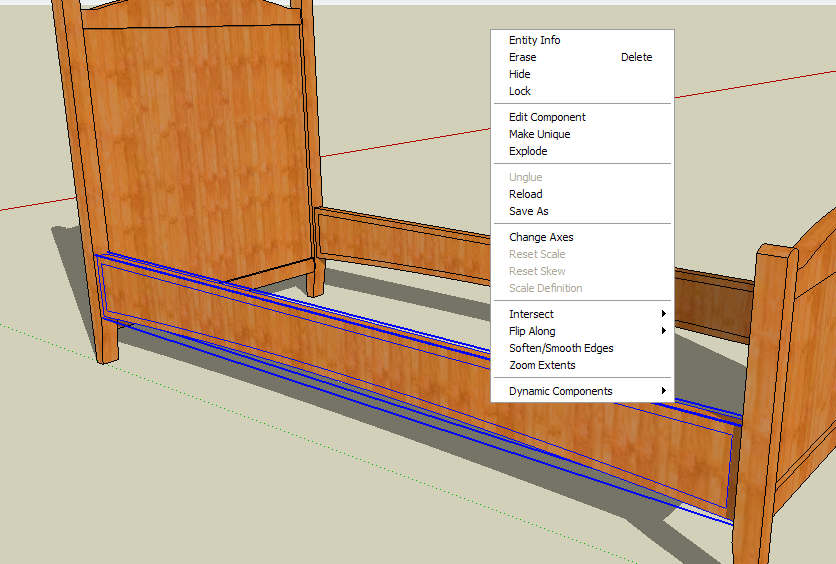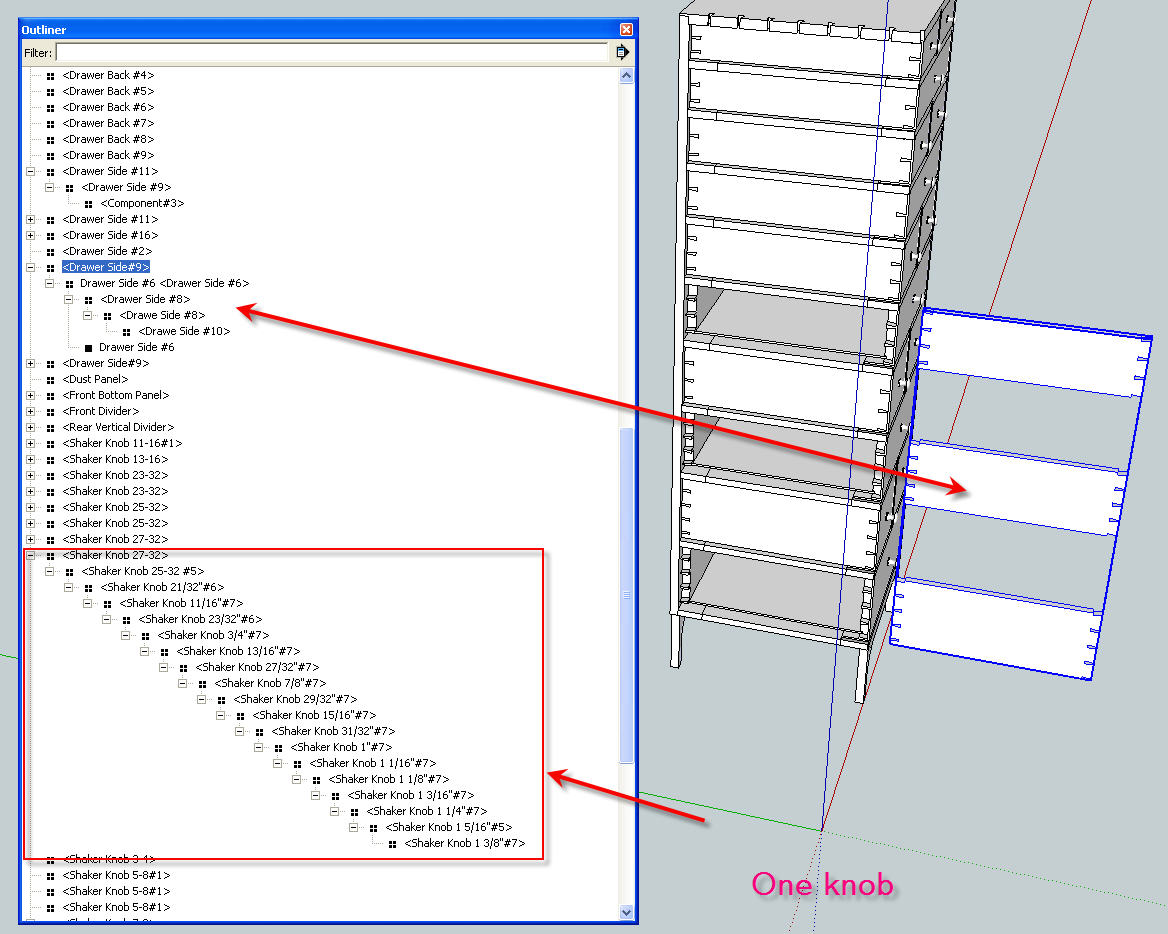Invitation to the SketchUcation collection
-
sorry guys, but I really can't get it! I can rotate the axex but I spent the entire evening in trying to rotate the texture!
This is what I do:
I choose the material, I apply it to the component and when I right click the mouse pointed on the texured face of the component I can't find the option Texture-rotate. Where am I wrong?

-
The problem is that you applied the material to the component's "wrapper". That's my term. When you apply the material, open the component for editing, first. Then apply the material to the faces. Select one face that needs to have the material orientation edited, right click and you'll find Texture in the menu.
See if that helps.
Dave
-
thanks Dave, tomorrow morning (it's late now here) I'll try to fix the problem. I'll give you the feedback.
-
Mission accomplished!
-
Good work!

-
To elaborate Dave's advice; you can only position a texture/material on a single face. "Not single faces" are (and the "Texture item thus doesn't even appear in the context menu):
[list:32expikr][:32expikr]groups/components - like in your case. Dave explained how to solve this.[/ 32expikr]
32expikr]
[*:32expikr]curved/smoothed surfaces - let them be "really" curved or even just coplanar with a softened, dividing edge (in fact, these edges should be deleted instead of being dealt with like below). With curved/smoothed surfaces however you can do the following- Go to View > Hidden geometry; this will reveal the "facets" building up a curved surface
- these facets can be manipulated like single faces - i.e. in this case you can position a texture on one
- Now select the Paint bucket tool and pres the Alt key > the tool will turn into an eyedropper/sampler tool
- sample the positioned material on the above "one" face
- Turn off hidden geometry (again; uncheck it in the View menu)
- Paint the whole, curved/smoothed surface with the positioned > sampled material.[/list
 32expikr]Sounds to be a lot more complicated and longer than doing it with a little routine...
32expikr]Sounds to be a lot more complicated and longer than doing it with a little routine...
-
Good shot Gaeius!
 I normally use the projection mode to texture curved surfaces and I'm going to try your method.
I normally use the projection mode to texture curved surfaces and I'm going to try your method. -
Projection is fast and handy but when the curve goes round too much, it is distorted on the sides. Or actually it is always distorted just in these cases it is too apparent.
With positioning however, though it may look "nicer", it is a bit tiresome. -
Actually I noticed that in a curved leg I made
-
Nice bed Keith.
Funny thing, though. The table looks like the bed.

-
Here are 2 new models that may meet the requirements for the collection. One is extra long twin bed made as a captians bed with drawers below the bed. The other is a twin pedestal dining room table.
Keith
http://sketchup.google.com/3dwarehouse/details?mid=f21822974c8c492085c5f690e9252fc5
http://sketchup.google.com/3dwarehouse/details?mid=615b800fb332525385c5f690e9252fc5Edited link to Table
-
I just posted this model in another thread, but I think its appropriate here.... Its a dynamic, reconfigurable door. I use it all the time for my woodworking plans...
-
Thanks Eric
-
This is the Heirloom Hope Chest orginally publised by Wood Magazine in Issue 142 (june/July 2002). I built this chest as a Christmas present to my wife in 2008.
From the original plans from Wood:

From my model:

-
Excellent!
-
Nice model! I really like it.
Did you use LayOut, or the CutList plugin to figure out how to build it?
-
@gaieus said:
To elaborate Dave's advice; you can only position a texture/material on a single face. "Not single faces" are (and the "Texture item thus doesn't even appear in the context menu):
[list:3i32cga8][:3i32cga8]groups/components - like in your case. Dave explained how to solve this.[/ 3i32cga8]
3i32cga8]
[*:3i32cga8]curved/smoothed surfaces - let them be "really" curved or even just coplanar with a softened, dividing edge (in fact, these edges should be deleted instead of being dealt with like below). With curved/smoothed surfaces however you can do the following- Go to View > Hidden geometry; this will reveal the "facets" building up a curved surface
- these facets can be manipulated like single faces - i.e. in this case you can position a texture on one
- Now select the Paint bucket tool and pres the Alt key > the tool will turn into an eyedropper/sampler tool
- sample the positioned material on the above "one" face
- Turn off hidden geometry (again; uncheck it in the View menu)
- Paint the whole, curved/smoothed surface with the positioned > sampled material.[/list
 3i32cga8]Sounds to be a lot more complicated and longer than doing it with a little routine...
3i32cga8]Sounds to be a lot more complicated and longer than doing it with a little routine...
Thanks for this Gaieus!
I cannot tell you the frustration I've had when trying to tweak some textures on certain surfaces that 'appeared' flat. The "Texture" part of the right-click menu just did not show up (as in the post above). All of these problem-surfaces (it turns out) had some kind of rounded edge-treatment applied (using follow-me). Using your advice, I was able to go back into several of my models and turn-on hidden geometry. Voila! -- I was able to isolate my flat-surfaces ad scale my textures the way I wanted. -
My first complex model in SketchUp. This is my interpretation of Christian Becksvoort's Shaker Collector Cabinet.
-
I'm new to SketchUp and there is still a lot I have to learn. I had already finished the knobs before I saw Tim Killen's video about Shaker Knobs on another blog.
I had seen this cabinet in a couple of different publications and I wanted to get the proportions and approximate measurements in case my woodworking skills take a quantum leap...
-
Interesting cabinet. It's a pretty big file for such a small cabinet. I purged unused stuff and got rid of 26 unused components and 4 unused materials. If you'd apply the materials to the faces instead of the components, you could eliminate one each of the Cherry and Maple materials. And why are the knobs buried in 17 component levels? The knobs are rather high poly for no larger than they are.
Why are there two copies of the right side panel in the same space? And why do you have a single group inside a component? There's a lot of unneeded nesting going on throughout. This makes it difficult to work with the model. I found three drawer sides in one component. So if you want to open one of those drawers, all three of those sides move out at the same time.

I'm not trying to be critical but I think your modeling could be a lot easier. It all looks like you're working pretty hard and you should need to do that.
By the way, where did you find this piece? I'm working on larger a Becksvoort Shaker piece right now. I've already done his little Classic Shaker table with two leg options and a chest of drawers
Advertisement







